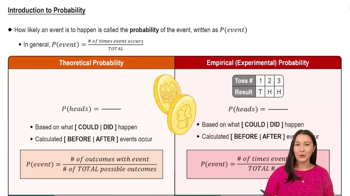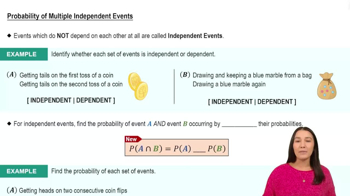Computer Variable Names A common computer programming rule was that names of variables must be between one and eight characters long. The first character can be any of the 26 letters, while successive characters can be any of the 26 letters or any of the 10 digits. For example, allowable variable names include A, BBB, and M3477K. How many different variable names are possible? (Ignore the difference between uppercase and lowercase letters.)
Table of contents
- 1. Intro to Stats and Collecting Data1h 14m
- 2. Describing Data with Tables and Graphs1h 55m
- 3. Describing Data Numerically2h 5m
- 4. Probability2h 16m
- 5. Binomial Distribution & Discrete Random Variables3h 6m
- 6. Normal Distribution and Continuous Random Variables2h 11m
- 7. Sampling Distributions & Confidence Intervals: Mean3h 23m
- Sampling Distribution of the Sample Mean and Central Limit Theorem19m
- Distribution of Sample Mean - Excel23m
- Introduction to Confidence Intervals15m
- Confidence Intervals for Population Mean1h 18m
- Determining the Minimum Sample Size Required12m
- Finding Probabilities and T Critical Values - Excel28m
- Confidence Intervals for Population Means - Excel25m
- 8. Sampling Distributions & Confidence Intervals: Proportion1h 12m
- 9. Hypothesis Testing for One Sample3h 29m
- 10. Hypothesis Testing for Two Samples4h 50m
- Two Proportions1h 13m
- Two Proportions Hypothesis Test - Excel28m
- Two Means - Unknown, Unequal Variance1h 3m
- Two Means - Unknown Variances Hypothesis Test - Excel12m
- Two Means - Unknown, Equal Variance15m
- Two Means - Unknown, Equal Variances Hypothesis Test - Excel9m
- Two Means - Known Variance12m
- Two Means - Sigma Known Hypothesis Test - Excel21m
- Two Means - Matched Pairs (Dependent Samples)42m
- Matched Pairs Hypothesis Test - Excel12m
- 11. Correlation1h 6m
- 12. Regression1h 50m
- 13. Chi-Square Tests & Goodness of Fit1h 57m
- 14. ANOVA1h 57m
4. Probability
Counting
Problem 4.4.29c
Textbook Question
Mega Millions As of this writing, the Mega Millions lottery is run in 44 states. Winning the jackpot requires that you select the correct five different numbers from 1 to 70 and, in a separate drawing, you must also select the correct single number from 1 to 25.
c. How does the probability compare to the probability for the old Mega Millions game which involved the selection of five different numbers between 1 and 75 and a separate single number between 1 and 15?
 Verified step by step guidance
Verified step by step guidance1
Understand the problem: We are comparing the probabilities of winning the jackpot in two versions of the Mega Millions lottery. The first version involves selecting 5 numbers from 1 to 70 and 1 number from 1 to 25. The older version involves selecting 5 numbers from 1 to 75 and 1 number from 1 to 15.
Calculate the total number of combinations for the current Mega Millions game. Use the combination formula: \( \binom{n}{r} = \frac{n!}{r!(n-r)!} \), where \(n\) is the total number of items to choose from, and \(r\) is the number of items to choose. For the current game, calculate \( \binom{70}{5} \) for the 5 numbers and multiply it by 25 for the single number.
Calculate the total number of combinations for the old Mega Millions game. Similarly, use the combination formula \( \binom{n}{r} \). For the old game, calculate \( \binom{75}{5} \) for the 5 numbers and multiply it by 15 for the single number.
Compare the probabilities: The probability of winning is the reciprocal of the total number of combinations. For the current game, the probability is \( \frac{1}{\binom{70}{5} \times 25} \). For the old game, the probability is \( \frac{1}{\binom{75}{5} \times 15} \). Compare these two probabilities to determine which game is harder to win.
Interpret the result: Based on the comparison, explain how the change in the number of possible combinations affects the likelihood of winning. Specifically, note whether the current game has a higher or lower probability of winning compared to the old game.
 Verified video answer for a similar problem:
Verified video answer for a similar problem:This video solution was recommended by our tutors as helpful for the problem above
Video duration:
3mPlay a video:
Was this helpful?
Key Concepts
Here are the essential concepts you must grasp in order to answer the question correctly.
Probability
Probability is a measure of the likelihood that a particular event will occur, expressed as a number between 0 and 1. In the context of lotteries, it quantifies the chances of selecting the correct numbers. Understanding how to calculate probability is essential for comparing different lottery formats, as it involves determining the total number of possible outcomes versus the number of favorable outcomes.
Recommended video:

Introduction to Probability
Combinatorics
Combinatorics is a branch of mathematics dealing with combinations and permutations of objects. In lottery scenarios, it helps calculate the number of ways to choose a set of numbers from a larger pool. For example, in the Mega Millions game, combinatorial calculations are used to determine how many different combinations of five numbers can be selected from 70, which is crucial for understanding the overall odds of winning.
Independent Events
Independent events are those whose outcomes do not affect each other. In the context of the Mega Millions lottery, the selection of the five numbers and the separate selection of the single number are independent events. This concept is important when calculating the overall probability of winning, as the total probability is the product of the probabilities of each independent event occurring.
Recommended video:

Probability of Multiple Independent Events

 7:11m
7:11mWatch next
Master Introduction to Permutations with a bite sized video explanation from Patrick
Start learningRelated Videos
Related Practice
Textbook Question
